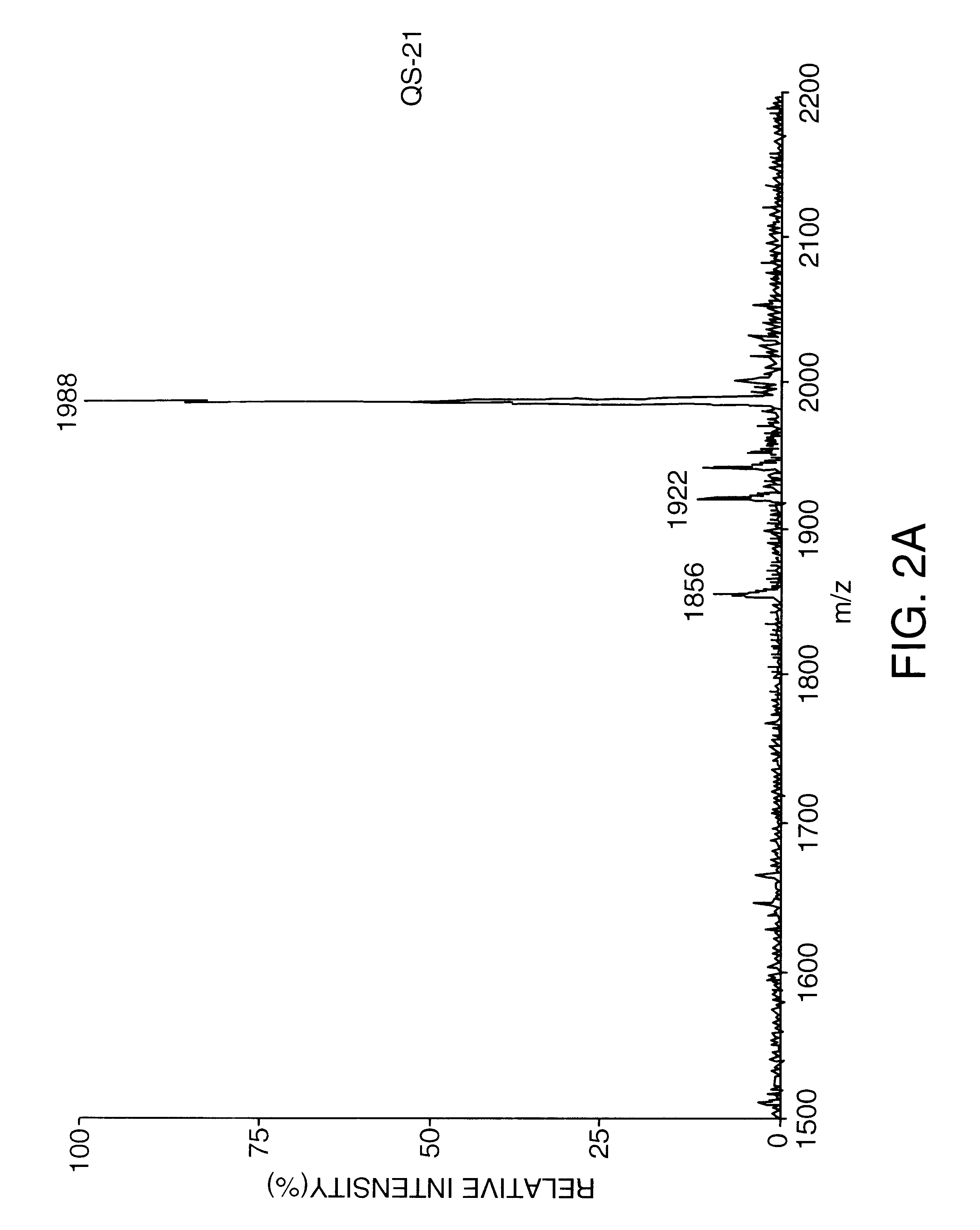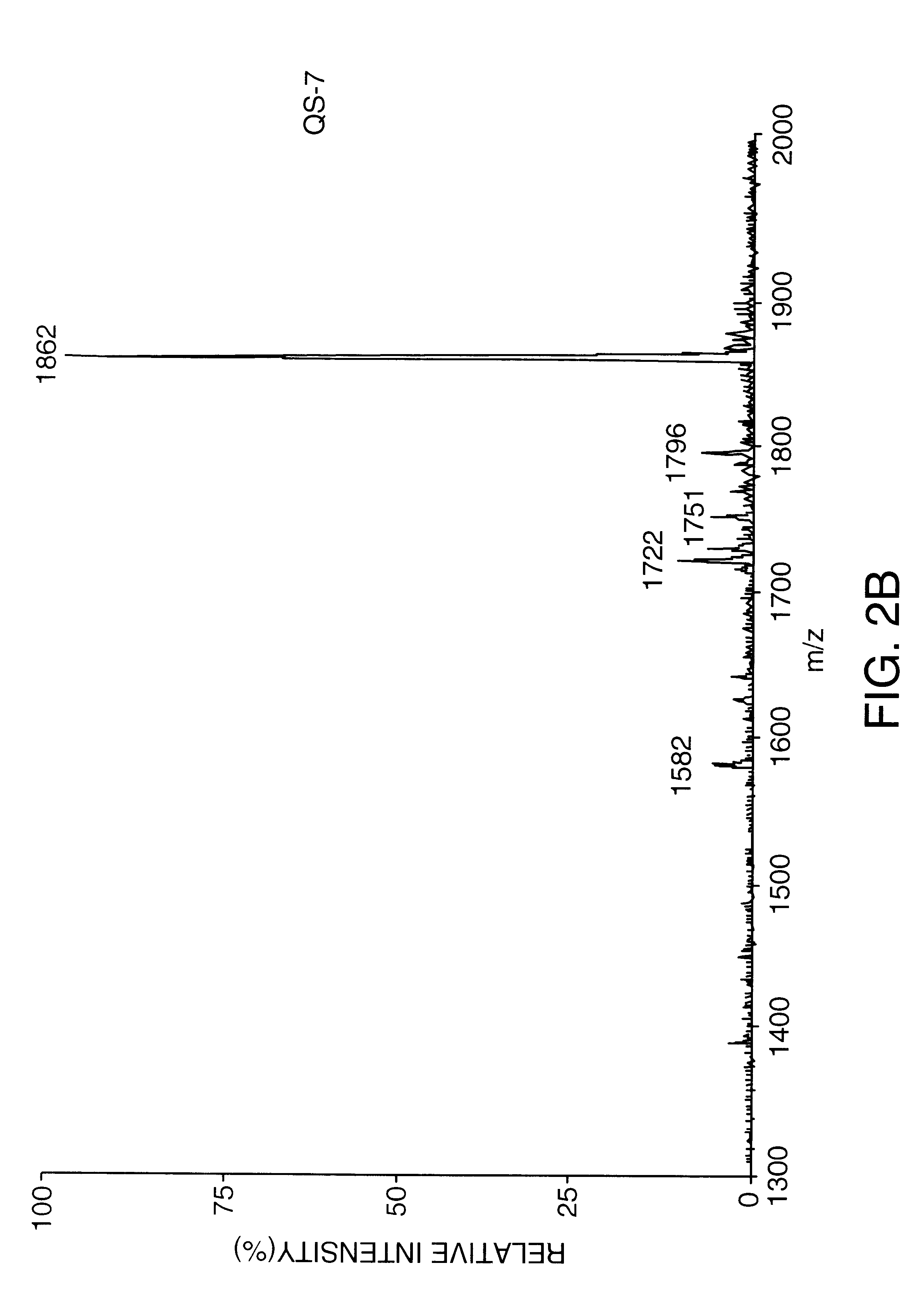Saponin compositions and uses thereof
a technology of saponin and composition, applied in the field of saponin composition, can solve the problems of not being desirable for use in veterinary practice or in pharmaceutical compositions for man, still exhibiting considerable heterogeneity, and not all saponins were active as adjuvants
- Summary
- Abstract
- Description
- Claims
- Application Information
AI Technical Summary
Problems solved by technology
Method used
Image
Examples
example 2
Purification of Substantially Pure QS-21 by C18 Chromatography
QS-21 intermediate, prepared in Example 1, was further purified by preparative reversed phase HPLC on a Vydac C18 column (10 micron particle size, 300 angstrom pore size, 25 cm length, 2.2 cm diameter). A 100 mg / ml solution of QS-21 intermediate was prepared in 38% actonitrile / 62% water / 0.15% trifluoroacetic acid (v / v / v). A 20 mg aliquot was then separated on the Vydac column under isocratic chromatographic conditions in 38% acetonitrile / 62% water / 0.15% trifluoroacetic acid. Sixteen chromatography runs under identical isocratic chromatography runs were carried out. Fractions that yielded substantially pure QS-21 (from in-process reversed phase HPLC analysis) were collected and pooled for a total volume of 930 ml. This was diluted to 1860 ml by the addition of HPLC grade water. The diluted pool was loaded onto a Vydac C18 column (20-30 micron, 15 cm length.times.2.5 cm internal diameter) equilibrated in water. The diluted ...
example 3
Alternative Method for Obtaining Substantially Pure QS-21
A suitable aqueous extract of Quillaja saponaria is adsorbed to polyvinylpolypyrrolidone (PVPP) at a ratio of 120 grams of PVPP per liter of 10% extract (w / v). The PVPP binds and separates tannins and polyphenolics from the soluble saponin fraction. The PVPP is removed by an appropriate method such as centrifugation or filtration. This is then followed by membrane filtration of the treated extract to remove small particulates. A sample is analyzed via in-process HPLC analysis and comparison to a QS-21 standard curve for determination of QS-21 concentration.
The saponins in the PVPP-treated extract are further concentrated by ultrafiltration (through a 30,000 dalton molecular weight cutoff membrane) to an approximate concentration of 8 to 12 grams per liter. The retentate, containing the saponin fraction, is then diafiltered against 5 volumes of purified water. The diafiltration retentate is then collected, analyzed for QS-21 co...
example 4
Purification of Substantially Pure QS-7 by C18 Chromatography
QS-7 intermediate, prepared as described in Example 1, was further purified on a Waters C18 column. A 100 mg / ml solution of QS-7 intermediate was dissolved in water. Twenty mg of this solution was eluted on C18 (0.78 cm ID.times.30 cm length, 10 micron) in a linear gradient of 80% water / 20% acetonitrile / 0.15% trifluoroacetic acid to 40% water / 60% acetonitrile / 0.15% trifluoroacetic acid over 75 minutes at a 2 ml / minute flow rate. A total of four runs were made and the QS-7 fractions were combined for a total of 19 mg of approximate 54% purity. This preparation was dissolved at 4 mg / ml in water and further purified by isocratic HPLC on the same column, equilibrated in 67% water / 33% acetonitrile / 0.15% trifluoroacetic acid. The collected fractions were diluted with an equal volume of water and adsorbed to C18 resin (20-30 micron) in a Buchner funnel, and washed with 90 ml water. The QS-7 was then eluted with 40 ml methanol. Th...
PUM
| Property | Measurement | Unit |
|---|---|---|
| particle size | aaaaa | aaaaa |
| particle size | aaaaa | aaaaa |
| particle size | aaaaa | aaaaa |
Abstract
Description
Claims
Application Information
 Login to View More
Login to View More - R&D
- Intellectual Property
- Life Sciences
- Materials
- Tech Scout
- Unparalleled Data Quality
- Higher Quality Content
- 60% Fewer Hallucinations
Browse by: Latest US Patents, China's latest patents, Technical Efficacy Thesaurus, Application Domain, Technology Topic, Popular Technical Reports.
© 2025 PatSnap. All rights reserved.Legal|Privacy policy|Modern Slavery Act Transparency Statement|Sitemap|About US| Contact US: help@patsnap.com



